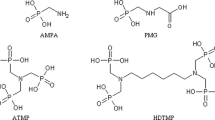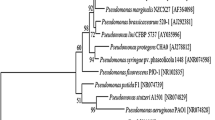Abstract
The broad-spectrum organophosphate hydrolase (OPH; EC 3.1.8.1) encoded by the organophosphate-degrading gene (opd) from Pseudomonas diminuta MG and Flavobacterium sp. ATCC 27551 possesses capabilities of both P-O bond hydrolysis (e.g. paraoxon) and P-F bond hydrolysis [e.g. sarin and diisopropylfluorophosphate (DFP)]. In the present study a 9.4-kb plasmid, pCL1, was used to transform the saprophytic fungus Gliocladium virens. pCL1 was derived from pJS294 by placing the fungal promoter (prom1) from Cochliobolus heterostrophus upstream and the trpC terminator from Aspergillus nidulans downstream of the opd gene. Southern analysis of restricted genomic DNA from various transformants indicated that integration occurred non-specifically at multiple sites. Western blot analysis of mycelial extracts from transformants confirmed the production of a processed form of the enzyme in the fungus. Maximal levels of OPH activity (rate of p-nitrophenol production from paraoxon) were observed after 168 h of culture and activity levels correlated with biomass production in mature vegetative growth.
Similar content being viewed by others
References
Baarschers WH, Heitland HS (1986) Biodegradation of fenitrothion and fenitrooxon by the fungus Trichoderma viride. J Agric Food Chem 34:707–709
Bumpus JA, Kakar SN, Coleman RD (1993) Fungal degradation of organophosphorous insecticides. Appl Biochem Biotechnol 39:715–726
Dave KI, Miller CE, Wild JR (1993) Characterization of organophosphorus hydrolases and the genetic manipulation of the phosphotriesterase from Pseudomonas diminuta. Chem-Biol Interactions 87:55–68
Dave KI, Phillips L, Luckow VA, Wild JR (1994) Expression and post-translational processing of a broad-spectrum organophosphorus neurotoxin degrading enzyme in insect tissue culture. Biotechnol Appl Biochem, in press
Davies RH, de Serres FJ (1970) Genetic and microbiological research techniques for Neurospora crassa. Methods Enzymol 27A:79–143
Dumas DP, Caldwell SR, Wild JR, Raushel FM (1989a) Purification and properties of the phosphotriesterase from Pseudomonas diminuta. J Biol Chem 264:19659–19665
Dumas DP, Wild JR, Raushel FM (1989b) Diisopropylfluorophosphate hydrolysis by a phosphotriesterase from Pseudomonas diminuta. Biotechnol Appl Biochem 11:235–243
Dumas DP, Durst HD, Landis WG, Raushel FM, Wild JR (1990) Inactivation of organophosphorus nerve agents by the phosphotriesterase from Pseudomonas diminuta. Arch Biochem Biophys 277:155–159
Fincham JR (1989) Transformation of fungi. Microbiol Rev 53:148–170
Fowler T, Berka RM, Ward M (1990) Regulation of the glaA gene of Aspergilus niger. Curr Genet 18:537–545
Harlow E, Lane D (1988) Antibodies: a laboratory manual. Cold Spring Harbor Laboratory, Cold Spring Harbor, N.Y.
Jeenes DJ, Mackenzie DA, Roberts IN, Archer DB (1991) Heterologous protein production by filamentous fungi. Biotechnol Genet Eng Rev 9:327–367
Lewis VE, Donarski WJ, Wild JR, Raushel FM (1988) The mechanism and sterochemical course at phosphorus of the reaction catalyzed by a bacterial phosphotriesterase. Biochemistry 27:1591–1597.
Miller CE (1992) Structure/function studies on the signal sequence of organophosphorus hydrolase of Pseudomonas diminuta in Escherichia coli. Ph.D. Dissertation, Texas A & M University
Mulbry WW, Karns JS (1989) Parathion hydrolase specified by the Flavobacterium opd gene: relationship between the gene and protein. J Bacteriol 171:6740–6746
Mulbry WW, Karns JS, Kearney PC, Nelson JD, McDaniel CS, Wild JR (1987) Identification of a plasmid-borne parathion hydrolase gene from Flavobacterium sp. by Southern hydridization with opd from Pseudomonas diminuta. Appl Environ Microbiol 51:926–930
Park YH, Kenerley CM, Stack JP (1992) Inoculum dynamics of Gliocladium virens associated with roots of cotton seedlings. Microbiol Ecol 23:169–179
Papavizas GC (1985) Trichoderma and Gliocladium: biology, ecology and potential for biocontrol. Annu Rev Phytopathol 23:23–54
Punt PJ, Segers ND, Busscher M, Pouwels PH, Van den Hondel CAMJJ (1991) Intracellular and extracellular production of proteins under the control of expression signals of the highly expressed Aspergillus nidulans gpdA gene. J Biotechnol 17:19–34
Ridout CJ, Lumsden RD, Hruschka WR (1992) Identification of mycelial polypeptides associated with gliotoxin-producing strains of the biocontrol fungus Gliocladium virens. Phytopathology 82:479–484
Sambrook J, Fritsch EF, Maniatis T (1989) Molecular cloning. A laboratory manual. Cold Spring Harbor Laboratories, Cold Spring Harbor, N.Y.
Serdar CM, Murdock DC, Rohde MF (1989) Parathion hydrolase gene from Pseudomonas diminuta MG: subcloning, complete nucleotide sequence, and expression of the mature portion of the enzyme in Escherichia coli. Bio/Technology 7:1151–1155
Steiert JG, Pogell BM, Speedie MK, Laredo J (1989) A gene coding for a membrane-bound hydrolase is expressed as a secreted soluble enzyme in Streptomyces lividans. Bio/Technology 7:65–68
Supak JM (1990) Genetically engineered pesticide biodegradation by Gliocladium virens. MS Dissertation, Texas A and M University
Thomas MD, Kenerley CM (1989) Transformation of the mycoparasite Gliocladium. Curr Genet 15:415–420
Turgeon BG, Garber RC, Yoder OC (1987) Development of a fungal transformation system based on selection of sequences with promoter activity. Mol Cell Biol 7:3297–3305
Turnbull IF, Rand K, Willetts NS, Hynes MJ (1989) Expression of the Escherichia coli enterotoxin subunit B gene in Aspergillus nidulans directed by the amdS promoter. Bio/Technology 7:169–174
Van den Hondel CAMJJ, Punt PJ, Gorcom RFM van (1991) Heterologous gene expression in filamentous fungi. In: Bennett JW, Lasure LL (eds) More gene manipulations in fungi. Academic Press, San Diego, USA, pp 396–428
Author information
Authors and Affiliations
Rights and permissions
About this article
Cite this article
Dave, K.I., Lauriano, C., Xu, B. et al. Expression of organophosphate hydrolase in the filamentous fungus Gliocladium virens . Appl Microbiol Biotechnol 41, 352–358 (1994). https://doi.org/10.1007/BF00221231
Received:
Revised:
Accepted:
Issue Date:
DOI: https://doi.org/10.1007/BF00221231




